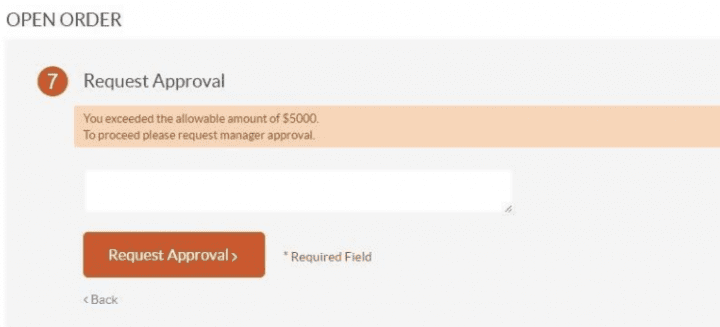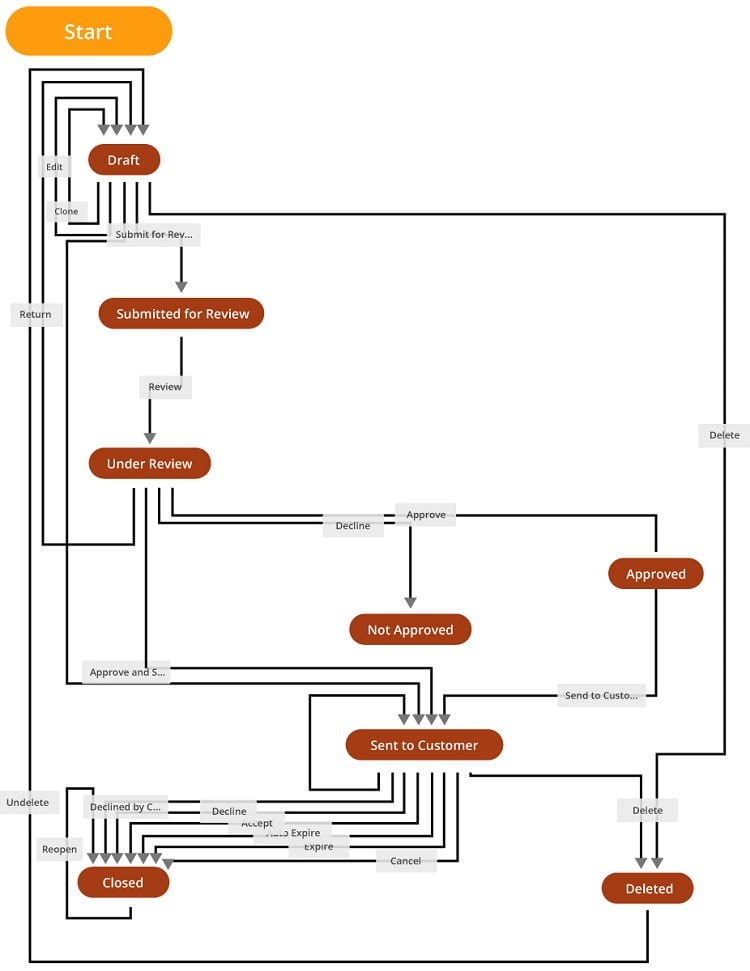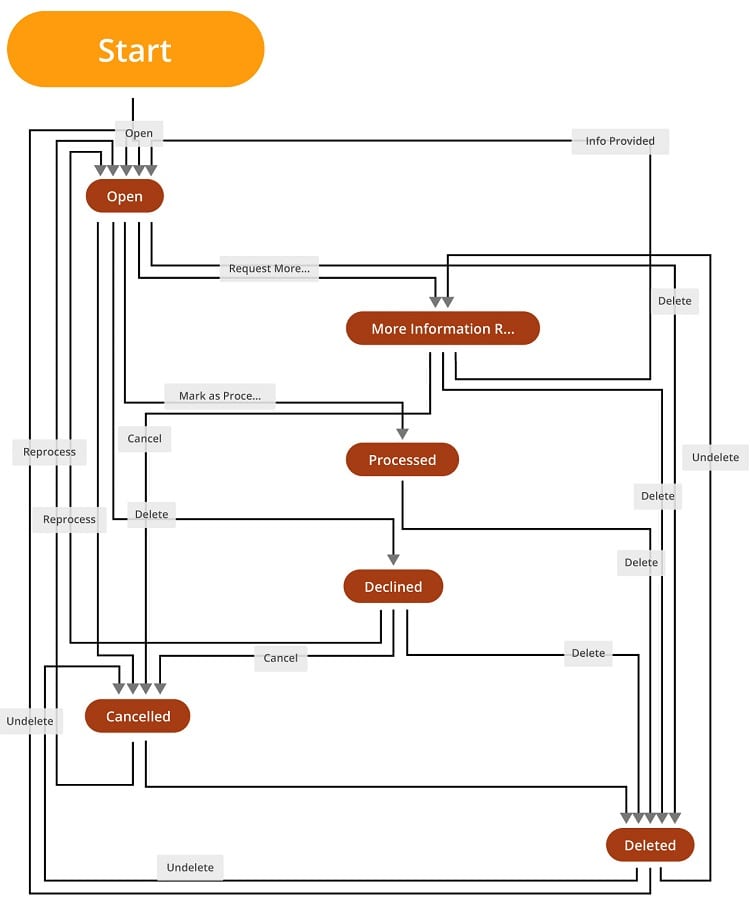navigation

Many B2B eCommerce brands have undertaken some form of automation reactively due to switching to remote work environments, managing the supply chain crisis, or streamlining customer service.
However, that is not enough. Forward-thinking B2B companies think ahead and look for flexibility within their workflows. Flexible workflows allow for experimentation and new ways of unlocking gains for long-term stability. It gives them peace of mind that they can weather unknown risks better and act on opportunities faster.
Oro’s research reveals that B2B sellers seek to improve productivity through automation and get their employees to build relationships instead of spending time on manually processing orders.
Thus, flexible workflows benefit both B2B sellers and buyers. Users can access personalized pricing, track the status of their orders without employee involvement, and brands can essentially run their stores on autopilot 24/7.

In this article, you’ll find out all about workflow automation and coordination in eCommerce, the benefits of workflow management in eCommerce, and some B2B process automation ideas you can implement in your eCommerce business.
What Is an Automated Workflow in eCommerce?
A workflow is a series of steps in a business process. It involves managing data and information in order to reach some business goal – be it reducing costs, manual effort, or optimizing resources. Workflow automation simply means automating these processes for increased speed and accuracy while eliminating errors associated with manual data entry or missing data.
More often than not, automating workflows implies replacing a human activity with a digital one.
One example of simple B2B workflow automation is automatic customer data synchronization between the CRM and the B2B eCommerce platform. With proper setup, it eliminates manual order entry and coordination tasks by sales representatives.
Furthermore, a flexible workflow automation engine allows businesses to tweak and optimize their workflows for more efficiency as time goes on.
4 Benefits of Workflow Automation in B2B eCommerce
There are many reasons why you might want to automate workflows in eCommerce B2B processes. Consider the following main benefits of workflow automation in eCommerce:
Enable data accuracy
Most eCommerce businesses generate an immense amount of new customer, inventory, or transactional data. When maintained by hand, this data might not get relayed when and where needed, leading to lost sales.
As more and more data accumulates, it can get scattered in siloes or get misplaced, putting a further strain on operations. Even with the best processes in place, so long as humans are introduced to the equation, there will always be a possibility of human error. Workflow automation minimizes or outright eliminates these concerns.
Cut down on costs
Businesses that automate manual tasks can perform them faster and with more precision. For example, if a single eCommerce rep must spend 30 minutes a day manually managing orders, automating this process will save them 130 hours of work over a year. This figure increases considerably once you multiply that by 10 reps.
The time, money, and effort saved can have a knock-on effect on other areas of business. For example, employees can spend more time on customer service, perform market research, competitor analysis, a/b testing, experimentation, and explore other creative business growth tactics.
Learn how to connect with your audience, expand into new markets, and minimize costs when growing your business
Scale your business
A typical eCommerce business depends on many important tasks, many of which tend to be repetitive. First of all, humans are physically limited by how much work they can perform. Manual data entry leads to typos and omissions. Spending time locating data or manually sending emails can take up too much time or lead to errors. As employee attention is diverted from time-sensitive to unproductive activities, there’s less time to focus on business growth initiatives.
For most brands, human assets are their biggest assets. Thus, tying employees up in unproductive activities that can be performed by software hampers your ability to increase revenues and act on growth opportunities.

Improve the customer experience
Customers are becoming accustomed to purchasing without the sales rep’s intervention, but they’re also looking for a friction-free and intuitive B2B buying experience. When the products, order data, and shipping information are tailored to their needs, customers feel like they’re getting the white glove treatment.
Workflow automation accomplishes both by helping eCommerce businesses introduce elements of self-service. When customers can purchase, manage their orders, and return without staff involvement, they save time and effort, making them come back to buy more.
How to Automate a B2B eCommerce Workflow for Your Business
Out of all business processes, it may be challenging to decide on what to automate. Here are some starting points for proper workflow coordination in eCommerce:
Focus on repetitive tasks
Create a list of tasks that would be excellent candidates for automation. The most unproductive, resource-draining tasks tend to be repetitive and involve handling data. Activities like reporting, emailing, coordinating, confirming, reminding, and miscellaneous data entry all fall into this category.
Examine and perfect your processes
Once you’ve identified the tasks to automate, analyze your processes. While many will be obvious (like emailing or reporting on data), some further investigation may be necessary. Talk to your employees and use activity tracking tools to help you pinpoint the bottlenecks that you could eliminate.
Start small and grow in complexity
Begin with workflows that will have the smallest impact on operations. By starting with a simpler process, you’ll gain the knowledge and experience needed for more complex ones. Look for an eCommerce solution with the right automation features, with the required integration connectors between systems, and monitor data for accuracy during the evaluation period.
9 Workflow Automation Ideas for B2B eCommerce
While many B2C operations are relatively simple, B2B eCommerce transactions are of higher value, take longer, and involve many decision-makers. Thus, the opportunities for workflow automation are also much greater. Here are some business processes that benefit from B2B automation in eCommerce:
Product data
Data entry is a time-consuming process that introduces the possibility of many mistakes. As product options and catalogs grow, managing all your product configurations, descriptions, specification sheets, and so on becomes difficult.
Having a singular, cloud-based, source of truth that manages product information across systems helps keep your product data organized. Explore our PIM (product information management) guide for more details:
Discover how to effectively combine PIM and B2B eCommerce
Order automation
When a B2B customer places an order on your site, many things must happen behind the scenes. From sending data to the ERP, updating inventory data, and notifying customers via email, all these things must be automated. These activities also involve many systems, so your workflows must make use of robust connections between your CRM, ERP, accounting, payment, and shipping providers.
Inventory synchronization
Effective inventory management is a crucial eCommerce function. With product catalogs into the millions, B2Bs can’t afford to keep too little or too much stock – they must closely match the inventory with demand.
For example, inventory automation tools enable you to achieve the following workflow:
- Your sales automation system receives a new order.
- The inventory management software assigns stock to the order, with the option to establish rules to ensure the most appropriate
- warehouse or store is utilized.
- A ‘ready for dispatch’ tag attaches to the order in your system.
- Warehouse management personnel receive all relevant information, including shipping labels and order specifics.
- Warehouse team members pick, pack, and ship the order.
- The system logs stock removal and updates inventory levels accurately.
- A notification automatically triggers if stock levels drop below a predetermined threshold, and in some cases, the system can also raise a purchase order with your supplier.
Customer onboarding
Businesses selling to other businesses need to deal with a wide variety of customers. Vendor and supplier onboarding processes vary and involve input from decision-makers which must be coordinated. Without automation, crucial elements like paperwork, training procedures, regulations, and email sequences can get lost in the mix. By automating these steps, employees can focus on more time-sensitive tasks like resolving customer complaints.
Customer segmentation
While personalization is a must in B2B, it depends on automation to achieve at scale. Integration between the CRM and eCommerce platforms helps you accurately and reliably perform targeted marketing initiatives.
For example, you can sort buyers performing bulk purchases of a specific product, or identify what business units within an organization tend to purchase and market more effectively to them.
Pricing automation
Automated pricing workflows offer many benefits to customers, such as reducing friction during the purchasing process. It’s also beneficial to B2Bs dealing with large product catalogs, complex product configurations, and a varied customer base.
Look for pricing workflows that dynamically calculate prices for each customer, allowing you to include customer-specific discounts, promotions, shipping, and other elements.
Order negotiation
B2B purchases rely on quotes, invoices, and tend to negotiate them on an individual basis. B2B eCommerce workflow automation allows business buyers to save time when requesting quotations or managing invoices and terms. For example, automated workflows can fire off email notifications or update approval statutes in the customer’s self-service portal.
Approvals management
Unlike in B2C eCommerce, business buyers purchase on behalf of companies. Companies tend to have different corporate structures, including purchasing approval processes. For example, automation allows a purchase order over a certain amount to send a notification to a decision-maker, which, after approval, automatically fulfills the order.
Returns management
Businesses selling to other businesses often maintain unique return, refund, and exchange criteria according to each customer.
Automating these processes reduces errors, speeds up the return process, and enhances the customer experience. Furthermore, you can maintain customer activity and inventory visibility by having data move freely between the CRM, ERP, and eCommerce systems.
Some Examples of B2B eCommerce Workflow Automation
Order approvals
Let’s consider an example of an order approval workflow during checkout. Your checkout typically starts with a quick order form or a shopping cart checkout page. As the customer moves through the steps, an order is submitted. However, before making payment or specifying shipping arrangements, the customer may need to get approval from a higher-up, such as a purchasing manager or the accounting department.

When the customer clicks “request approval”, the approving authority is notified, either accepting or rejecting the order. Once approved, the requester is automatically notified and the order is processed as usual. Here is how an automated workflow can look behind the scenes:

Requesting a quote
Customers looking to order large quantities or make repeat purchases will like to know whether certain products on your site are negotiable. You can include a “request a quote” button on your product pages, and let automated workflows perform the rest. What’s more, this option can be made available for specific products and to specific customers. Here’s how it could look on your website:

When the customer requests a quote, automated workflows turn on behind the scenes. They can either request more information from the customer, or you can supply them with a quote based on the information they’ve provided. Thus, human intervention is only required in rare cases.

Look for Built-in Workflow Automation in eCommerce Vendors
To realize maximum benefits from eCommerce automation, a holistic, whole-company approach is required. Start by analyzing your processes, forming your goals, getting stakeholders on board, and selecting the right tool for the job.
When evaluating your B2B eCommerce vendors, pay close attention to their ability to automate B2B eCommerce workflows out of the box. Without a strong workflow automation engine to start with, you risk investing in workarounds and coded modifications that only increase complexity and hamper your ability to grow over time.
Thankfully, B2B-specific solutions such as OroCommerce offer the robustness, flexibility, and security that help businesses better position themselves for the future. More often than not, the only thing stopping B2Bs from embracing the benefits of B2B eCommerce workflow automation is taking the first step.
Discover how to leverage B2B eCommerce workflows for improved productivity and customer experience
Frequently Asked Questions
What is B2B eCommerce workflow automation?
B2B eCommerce workflow automation refers to the use of automated processes and technology to streamline and optimize the various steps involved in the B2B eCommerce process, such as order processing, inventory management, shipping and delivery, payment processing, and customer service, with the aim of improving efficiency, reducing errors, and enhancing the overall customer experience.
How does B2B eCommerce workflow automation improve order management?
B2B eCommerce workflow automation improves order management by streamlining order processing, inventory management, order tracking, and shipping and delivery. It can also provide real-time visibility into order status and inventory levels, enabling businesses to make more informed decisions and optimize their operations.
How does B2B eCommerce workflow automation streamline the quoting and pricing process?
B2B eCommerce workflow automation can streamline the quoting and pricing process in the following way:
1. Automated Quoting: When a customer submits a request for a quote, the B2B eCommerce system can automatically generate a quote based on predefined pricing rules and customer-specific pricing agreements. This can be done in real-time, with the customer receiving an instant quote.
2. Approval Workflows: If the quote requires approval from a manager or other team member, the B2B eCommerce system can automate the approval process. This can involve sending automated notifications to the relevant team members, with the option to approve or reject the quote online.
3. Pricing Rules: The B2B eCommerce system can be configured to apply different pricing rules based on various factors, such as the customer’s order history, the volume of the order, or the products being ordered. This can help to ensure that customers receive accurate and competitive pricing.
Are there any specific challenges to consider when implementing B2B eCommerce workflow automation?
Yes, there are specific challenges to consider when implementing B2B eCommerce workflow automation. These may include the need to integrate with existing systems and processes, ensuring data accuracy and consistency across different systems, managing complex pricing and discount structures, and ensuring that the system can handle the unique requirements of B2B transactions, such as purchase orders and invoicing.
Additionally, there may be resistance from employees who are accustomed to manual processes, and there may be a need for training and change management to ensure successful adoption of the new system.



